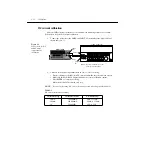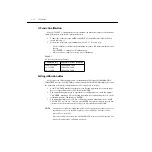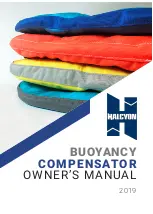
Calibration considerations
When performing the calibration procedures:
•
Make sure that the equipment is properly warmed up and connected to the appropriate
input jacks. Also make sure that the correct input jacks are selected with the INPUTS
switch.
•
Make sure the calibrator is in operate before you complete each calibration step.
•
Always let the source signal settle before calibrating each point.
•
Do not connect test equipment to the Model 2010 through a scanner or other switching
equipment.
•
If an error occurs during calibration, the Model 2010 will generate an appropriate error
message. See Appendix B for more information.
•
Always allow the calibrator to settle before pressing ENTER to complete each step.
(There is a “u” on the display of the 5700A Calibrator that is the settle annunciator).
WARNING
The maximum common-mode voltage (voltage between INPUT LO and
chassis ground) is 500V peak. Exceeding this value may cause a breakdown
in insulation, creating a shock hazard. Some of the procedures in this section
may expose you to dangerous voltages. Use standard safety precautions when
such dangerous voltages are encountered to avoid personal injury caused by
electric shock.
Calibration code
Before performing comprehensive calibration, you must first unlock calibration by entering
the appropriate calibration code.
Front panel code
For front panel calibration, follow these steps:
1.
Access the calibration menu by pressing SHIFT CAL, and note that the instrument
displays the following:
CAL: DATES
2.
Use the up or down range key to scroll through the available calibration parameters until
the unit displays RUN, and then press ENTER.
3.
The Model 2010 then prompts you to enter a code:
CODE? 000000
The factory default code is 002010. Use the left and right arrow keys to move among the
digits, use the up range key to increment numbers, and press the down range key to
specify alphabetic letters. Confirm the code by pressing ENTER.
Calibration
2-3
Summary of Contents for 2010
Page 14: ...1 Performance Verification 1 Performance Verification...
Page 28: ...2 Calibration 2 Calibration...
Page 53: ...3 Routine Maintenance 3 Routine Maintenance...
Page 56: ...4 Troubleshooting 4 Troubleshoot ing...
Page 74: ...5 Disassembly 5 Disassembly...
Page 83: ...CONFIDENTIAL PROPRIETARY...
Page 84: ......
Page 85: ......
Page 86: ......
Page 87: ...6 Replaceable Parts 6 Replaceable Parts...
Page 98: ...CONFIDENTIAL PROPRIETARY...
Page 99: ...CONFIDENTIAL PROPRIETARY...
Page 100: ......
Page 101: ...A Specifications A Specifications...
Page 107: ...B Calibration CommandReference B Calibration CommandRef erence...
















































